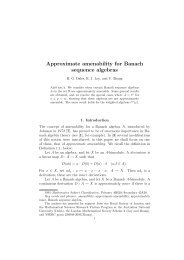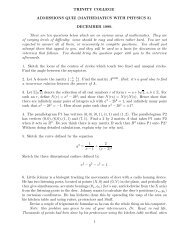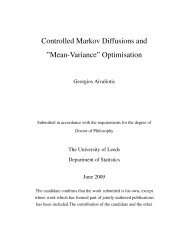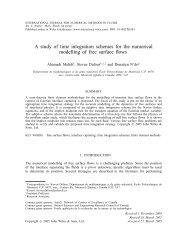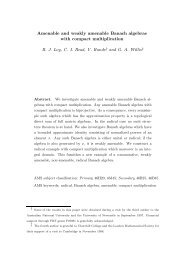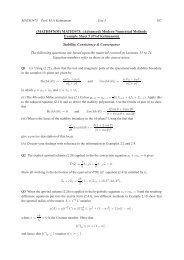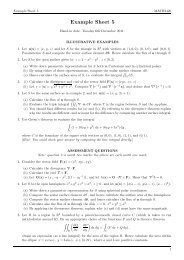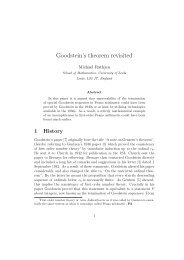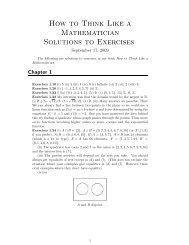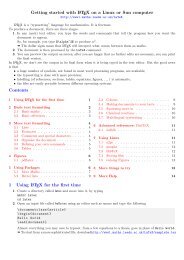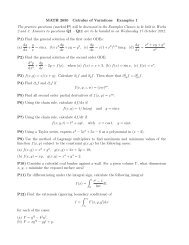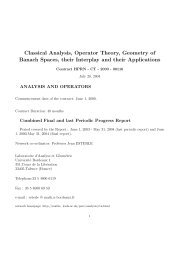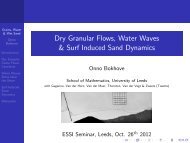DIFFERENTIAL GEOMETRY EXAMPLES 1
DIFFERENTIAL GEOMETRY EXAMPLES 1
DIFFERENTIAL GEOMETRY EXAMPLES 1
Create successful ePaper yourself
Turn your PDF publications into a flip-book with our unique Google optimized e-Paper software.
<strong>DIFFERENTIAL</strong> <strong>GEOMETRY</strong><br />
<strong>EXAMPLES</strong> 1<br />
Do try these! Experience shows that those who do the example sheets<br />
regularly do much better in the final exam.<br />
SECTION A: MATH 3113 AND 5113<br />
1. Should be revision! Let R : I → R 2 be the smooth parametrized<br />
curve defined by<br />
γ(t) = ( 2t/(t 2 + 1) , (t 2 − 1)/(t 2 + 1) ) (t ∈ R) .<br />
(i) Show this is a regularly parametrized curve. (ii) Find its total<br />
length. (iii) Find a unit speed reparametrization (please simplify your<br />
answer). (iv) What is its track?<br />
2. (i) Let γ : I → R n be a smooth regularly parametrized curve<br />
( and T(t) = γ ′ /|γ ′ (t)| the unit tangent vector. Show that γ ′′ (t) · T(t) =<br />
d<br />
dt |γ′ (t)| ) . [This says that the tangential component γ ′′ (t) ·T(t) of the<br />
the acceleration vector is the rate of change of the speed.] This directed<br />
magnitude is positive if the tangential part of the acceleration vector<br />
is in the ‘forward’ direction T(t) and negative if it’s in the backward<br />
direction −T(t).]<br />
(ii) Recall the formula<br />
k(t) =<br />
{<br />
1<br />
γ ′′ (t) −<br />
|γ ′ (t)| 2<br />
( ) }<br />
γ ′′ (t) · γ ′ (t)<br />
γ ′ (t) = γ′′ ⊥ (t) (t ∈ I)<br />
|γ ′ (t)| 2 |γ ′ (t)| 2<br />
for the curvature vector of a smooth regularly parametrized curve γ :<br />
I → R n and the formula ˜k(s) = ˜γ ′′ (s) (s ∈ J) for the curvature vector<br />
of its unit speed reparametrization ˜γ : J → R n . Show that these two<br />
formulae agree, i.e., that ˜k(s) = k(τ(s)) ∀s ∈ J where ˜γ = γ ◦ τ.<br />
3. Calculate the signed curvature, total curvature, and thus the<br />
rotation index, of the closed curve γ(t) = ( 5 sin(6πt), 5 cos(6πt) ) (t ∈<br />
[0, 1]). Explain your result geometrically.<br />
4. Consider the curve given by<br />
γ(t) = ( 20 cos(t) − 6 cos(10t) , 20 sin(t) − 6 sin(10t) ) .<br />
This is a curve called an epitrochoid. (i) Show that this curve is periodic<br />
and give its period. It thus defines a smooth closed curve. (ii) Show<br />
that it is regular. (iii) Show that the signed curvature is always positive.<br />
(iv) Sketch the curve and determine its rotation index geometrically.<br />
[You may use Maple to get an accurate picture of the curve but try to<br />
work out what it looks like first by hand.] (v) The curve is given by the<br />
trace of a point on the flange of a wheel which rolls without slipping<br />
around a larger circle. Can you sketch this and work out the radii of<br />
1
2<br />
the circle and wheel and the distance of the point from the centre of<br />
the wheel which give the above formula?<br />
5. (i) The winding number. Let γ : [a, b] → R be a smooth closed<br />
plane curve and let p be a point in the plane which is not on the<br />
track of γ. Then the winding number of γ with respect to p is the<br />
number of times the point γ(t) goes round p. More precisely, we can<br />
write γ(t) − p = r(t) (cosϕ(t), sin ϕ(t)) (t ∈ [a, b]) for some smooth<br />
functions r : [a, b] → (0, ∞) and ϕ : [a, b] → R; then the winding<br />
number is (1/(2π))(ϕ(b)−ϕ(a)). The winding number depends only on<br />
which component of R 2 −γ[a, b] the point p lies in (proof not required).<br />
Write down the winding number for each such component for (A) the<br />
epitrochoid above with (a) p = (0, 0), (b) p = (20, 0), (c) p = (40, 0);<br />
(B) the curves shown.<br />
(ii) Write down the rotation indices for the four curves shown (these<br />
do not depend on a point p).<br />
Figure 1. Curves for Q. 5.
<strong>DIFFERENTIAL</strong> <strong>GEOMETRY</strong><br />
<strong>EXAMPLES</strong> 1: HINTS<br />
3<br />
PLEASE TRY THEM ON TWO DIFFERENT<br />
OCCASIONS BEFORE READING THE HINTS<br />
1. (i) The total length is the integral over the whole parameter interval,<br />
i.e., from −∞ to +∞, of the speed. (iv) This should be obvious if you’ve<br />
simplified the answer to (iii).<br />
2. (i) Calculate d dt 〈γ′ (t),γ ′ (t)〉 = d dt |γ′ (t)| 2 in two different ways. (ii) We<br />
have a composition of functions (function of a function): ˜γ = γ ◦ τ, i.e.<br />
˜γ(s) = γ(t) where t = τ(s). Write down the chain rule expression for d˜γ/ds<br />
and think about what dt/ds is equal to; then differentiate again to get an<br />
expression for ˜γ ′′ (s) = d 2˜γ/ds 2 .<br />
3. Use the formula for the signed curvature.<br />
4. (ii) Calculate |γ ′ (t)| 2 . Use fact that the sin and cos of an angle vary<br />
between −1 and +1 to show that this is never zero. (iii) Again estimate<br />
and don’t work out unnecessary quantities. (iv) Don’t try to work out the<br />
signed curvature and integrate it — this is hard; just think geometrically<br />
about how many times the tangent to the curve rotates during one circuit.<br />
Is it 9 or 10? (v) Does the wheel rotate round the large circle 10 times or 9<br />
times? Why? The three numbers asked for are whole numbers.<br />
5. (i) Just think geometrically about how many times the ‘radius’ γ(t)−p<br />
rotates.<br />
(ii) This time, think about how many times the unit positive tangent<br />
rotates.
4<br />
<strong>DIFFERENTIAL</strong> <strong>GEOMETRY</strong><br />
<strong>EXAMPLES</strong> 1<br />
SECTION B: MATH 5113 ONLY<br />
1. Find a smooth parametrized curve with track given by<br />
{(0, y) : y ≥ 0} ∪ {(x, 0) : x ≥ 0} .<br />
Is your curve regular? Might there exist a regular curve with this track?<br />
2. (i) Prove the AM-GM inequality:<br />
√<br />
ab ≤<br />
1(a + b) for all non-negative numbers a and b.<br />
2<br />
Prove that equality occurs if and only if a = b.<br />
*(ii) What is the generalization to n numbers. Can you prove it?<br />
3. (i) Prove that, for any real numbers a 1 , a 2 , b 1 , b 2 ,<br />
( 2∑<br />
) 2 2∑ 2∑<br />
a i b i ≤ a 2 i b 2 i.<br />
i=1 i=1 i=1<br />
When does equality occur?<br />
*(ii) What is the generalization to 2n numbers. Can you prove it?
<strong>DIFFERENTIAL</strong> <strong>GEOMETRY</strong><br />
<strong>EXAMPLES</strong> 1: HINTS<br />
5<br />
PLEASE TRY THEM ON TWO DIFFERENT<br />
OCCASIONS BEFORE READING THE HINTS<br />
1. There is a smooth function f : R → R which is identically zero on<br />
{x ∈ R : x ≤ 0},and positive on {x ∈ R : x > 0}. Sketch the graph of<br />
such a function. What are the values of f(0), f ′ (0), f ′′ (0),...? Can you<br />
give a formula for such an f? If not, search some analysis books. Use f to<br />
manufacture the desired curve.<br />
2. (i) Square up ...<br />
3. (i) Write RHS − LHS as a perfect square.



